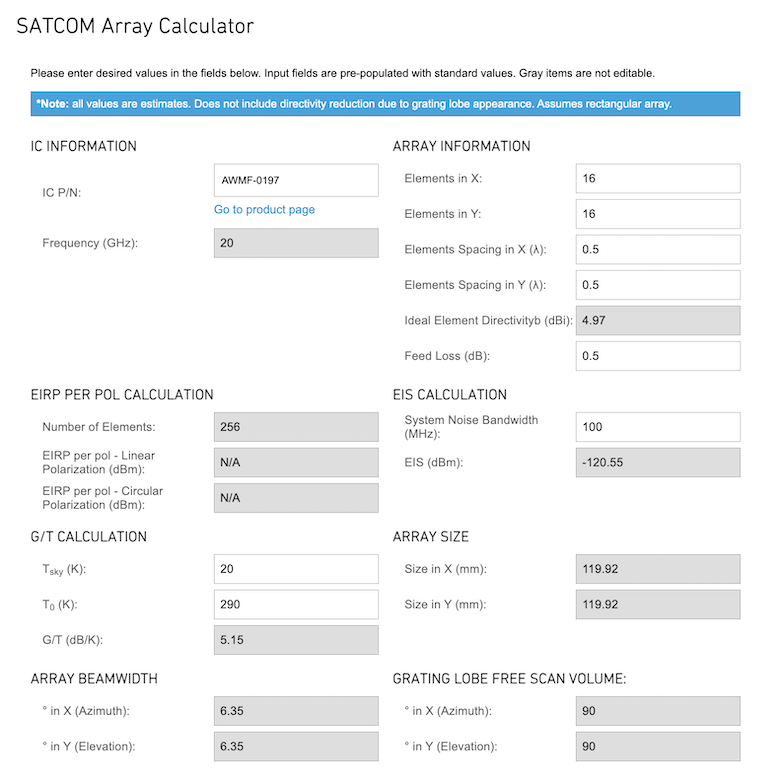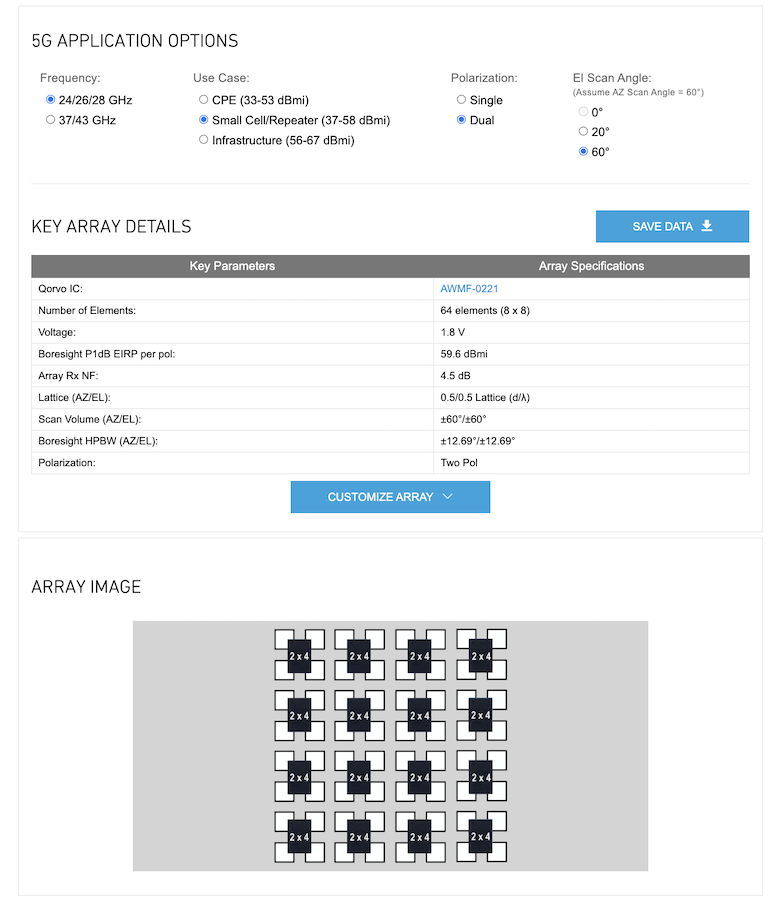Simplify Complex Antenna Designs with Qorvo’s New 5G and SATCOM Array Calculators
August 26, 2025
Designing a high-performance, energy-efficient antenna array for 5G or SATCOM applications is no small feat. It requires deep expertise, precise calculations, and the ability to balance a wide range of system-level trade-offs. To support engineers facing these challenges, Qorvo offers a suite of interactive design tools tailored to modern RF and antenna system needs.
Within the Qorvo Design Hub interactive tools, engineers can access a broad collection of calculators and resources that streamline complex design tasks. Among the latest additions are two powerful RF tools— the SATCOM Array Calculator and the 5G Array Calculator—purpose-built to help RF designers make smarter, faster decisions. Whether you’re optimizing for gain, power efficiency or thermal performance, these calculators can provide the insight you need to move your design forward with confidence.
1. SATCOM Array Calculator
This tool calculates your SATCOM array size and specifications based on Qorvo beamforming ICs. The calculator provides a quick method to study the array design space, estimate link budgets, optimize physical and RF trade‑offs and accelerate early-stage SATCOM terminal engineering.
Key Benefits:
- Reduces guess work, enabling faster, more confident design decisions.
- Calculates EIRP, G/T, and EIS, based on antenna size, element count, polarization, feed loss, and IC parameters, offering a quick system-level snapshot without manual calculation.
- Physical dimensions (array X/Y size in mm), beamwidth, and scan volume limits including grating-lobe‑free scan sectors are also created, helping ensure mechanical and performance compliance early in design.
- Incorporates real Qorvo BFIC specifications that help select the right configuration for the desired performance.
- Interactive, online tool (no install needed), it expedites trade-offs and iterations on array parameters, reducing time to market compared to manual spreadsheets or simulators.
With this calculator, valuable array design information can be generated, making design easier and faster.

2. 5G Array Calculator
Calculate your 5G array size and specifications based on Qorvo ICs. Active antenna design is a complex and novel skill that many new to this technology are not yet familiar. The array calculator is used to develop a proof-of-concept array with reliable calculations and to explore design trade-offs quickly.
Key Benefits:
- Taping into data from almost 2,000 5G use cases (Small Cell, CPE, GnB), the calculator offers key advice in relation to desirable frequency bands, antenna sizes and scan volumes.
- Creates a preliminary layout of the antenna based on the calculations.
- Offers customizable element spacing, feed loss, system noise bandwidth and temperature constants.
- Estimates EIS, EIRP, array beamwidth and grating lobe free scan volume.

Get Started Today
These two calculators are free and designed to give Qorvo Antenna developers an edge, located on Qorvo’s Design Hub on the Interactive Tools & Calculators webpage.
Need help or want to learn more? Reach out to appsupport@qorvo.com for expert assistance. For technical support please visit Qorvo.com or reach out to Technical Support.
About the Authors
Our authors bring a wealth of technical expertise in developing and optimizing wireless solutions for advanced technologies. With a deep understanding of customer needs and industry trends, they collaborate closely with our design teams to drive innovation and deliver cutting-edge solutions that support industry-leading products.
Thank you to our main contributors to this article, David Schnaufer (Technical Marketing Manager), Amy Corman (Strategic Marketing Communications Manager) and David Corman (Chief Systems Architect).
Have another topic that you would like Qorvo experts to cover? Email your suggestions to the Qorvo Blog team and it could be featured in an upcoming post. Please include your contact information in the body of the email.